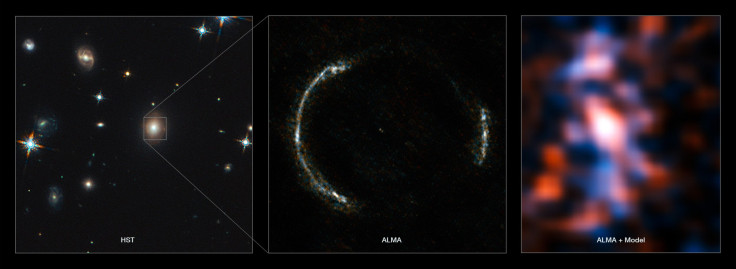Gravitational Lens Reveals Distant Galaxy In Unprecedented Detail

As Einstein’s theory of general relativity tells us, gravity can warp space-time. This warping of the fabric of the universe also results in a phenomenon known as “gravitational lensing,” wherein strong gravitational fields act as lenses --“bending” light as it travels through the cosmos -- allowing scientists to catch a glimpse of what might otherwise have remained invisible.
Now, scientists at the Atacama Large Millimeter/submillimeter Array (ALMA) observatory in the Atacama Desert in Chile have used this particular characteristic of the universe we inhabit to observe, in unprecedented detail, formation of stars in a galaxy far, far away. This gigantic galaxy -- named SDP.81 -- is located 11.7 billion light-years from Earth in the constellation Hydra, and is forming stars at a rate hundreds to thousands of times faster than what's seen in the Milky Way.
“In the months following that observation, at least seven groups of scientists have independently analyzed the ALMA data on SDP.81. This flurry of research papers has divulged unprecedented information about the galaxy, including details about its structure, contents, motion, and other physical characteristics,” ALMA said, in a press release. Moreover, since ALMA is composed of several antennas separated by a distance of up to 9 miles, the images have a resolution nearly six times greater than those taken using the Hubble Space Telescope.
“ALMA's huge collecting area, the large separation of its antennas, and the stable atmosphere above the Atacama Desert all lead to exquisite detail in both images and spectra. That means that we get very sensitive observations, as well as information about how the different parts of the galaxy are moving,” Rob Ivison, co-author of two of the eight papers based on the findings and the European Southern Observatory’s director for science, said, in the statement.
The images, which allow us to glimpse the galaxy as it was just 2.4 billion years after the Big Bang, show that it possessed massive clumps of stars nearly 200 light-years across. This is the first time the formation of stars has been seen at such an enormous distance.
The images also indicate, again for the first time ever, the existence of a supermassive black hole at the center of the galaxy in the foreground -- only 4 billion light-years away -- which is causing it to act as a gravitational lens.
“This one dataset has spawned an entire series of highly intriguing research, confirming that ALMA offers the astronomical community new avenues to probe the distant universe,” Todd Hunter, an astronomer at the National Radio Astronomy Observatory in the U.S. and co-author of one of the papers, said, in the statement.
© Copyright IBTimes 2025. All rights reserved.






















